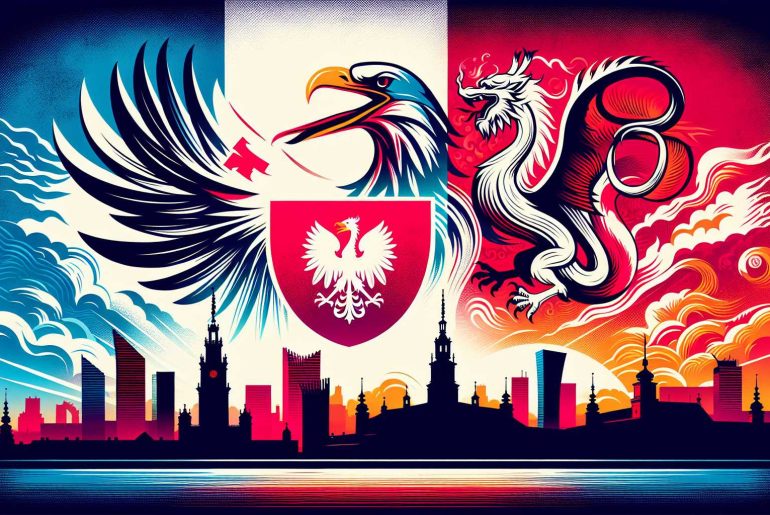
Poland is a country with a deep history and rich cultural traditions. It has many iconic symbols, each with its own unique story and meaning. For example, the White Eagle Emblem stands for strength and freedom. It’s a powerful symbol of the nation’s spirit. Then there’s the Wawel Dragon, which represents protection and power. It’s a fascinating symbol that shows how myths and legends are a big part of Poland’s identity.
Other important symbols include the Polish National Flag, the Partisan Cross, and the Amber Amulet. Each of these has its own significance. The flag represents the country’s pride and unity. The Partisan Cross is a symbol of resistance and bravery. And the Amber Amulet? It’s a symbol of health and protection, deeply rooted in Polish folklore.
These symbols are more than just images or objects. They tell the story of Poland’s past, its struggles, and its victories. They give us a glimpse into the traditions and beliefs that have shaped Polish culture over the years. So, when you see these symbols, remember the rich history and the stories behind them. They’re a big part of what makes Poland unique.
The White Eagle Emblem
The White Eagle Emblem is a powerful symbol of Poland, representing the nation’s strength, freedom, and rich history. This emblem, which features a majestic white eagle against a red background, has deep roots in Poland’s medieval legends and has changed over the years to reflect the nation’s shifting political and social landscape. It’s more than just an image on the coat of arms; it’s a symbol of Poland’s unbreakable spirit and cultural identity, especially during difficult times like partitions and occupations.
So, why is the White Eagle Emblem so significant? For starters, it showcases the national colors of Poland, white and red, which are symbols of courage and nobility. These aren’t just colors; they tell a story of a nation’s relentless pursuit of freedom and peace, despite facing numerous challenges throughout history.
The emblem’s journey through time is a testament to Poland’s resilience and unity. From its legendary origins to its role in modern-day Poland, the White Eagle Emblem has been a constant reminder of the country’s struggle for sovereignty and its aspirations for a peaceful future. It’s a symbol that connects Poles with their history and with each other, fostering a sense of pride and belonging.
In a nutshell, the White Eagle Emblem isn’t just a historical symbol; it’s a living part of Poland’s identity. It reminds us of the country’s past struggles and victories, encouraging unity and perseverance. Whether you’re looking at a flag, a coat of arms, or any other representation of Poland, the White Eagle stands out, proudly embodying the nation’s enduring spirit and cultural heritage.
The Polish National Flag
The Polish National Flag is a powerful symbol of Poland’s identity, characterized by its white and red stripes. Adopted in 1919, the flag’s design is simple but meaningful. The white represents peace and purity, while the red stands for the sacrifices made in the struggle for freedom and sovereignty. Throughout history, during times of division, war, and occupation, this flag has been a symbol of Polish resilience and pride.
Its straightforward design reflects the Polish value of honesty. The flag is more than just a symbol; it serves as a unifying force for Poland’s diverse population, bringing together people with a shared history and collective goals.
Let’s delve deeper into what makes this flag so special. For example, during national celebrations or international sporting events, you can see the Polish flag everywhere, demonstrating national pride and unity. This widespread use highlights its importance in fostering a sense of belonging and community among Poles, regardless of their background or beliefs.
The Partisan Cross
The Partisan Cross is a significant symbol in Poland, representing the bravery and determination of the Polish resistance during World War II. It honors the Armia Krajowa and other groups who bravely fought against the Nazi occupation. The design of the Partisan Cross is straightforward but carries a deep meaning, reminding everyone of the fight for freedom and the sacrifices made for Poland’s independence. It’s often seen at ceremonies and memorials, showing the country’s deep respect for those who fought for liberation, keeping their memory alive in Polish society.
This emblem isn’t just a piece of history; it’s a testament to the resilience and fighting spirit of the Polish people. Whenever you see the Partisan Cross at events or on monuments, it’s a powerful reminder of Poland’s struggle and the enduring strength of its people. It’s more than just a symbol; it’s a piece of Poland’s identity, illustrating the nation’s journey towards sovereignty and the price paid for it.
To truly understand the importance of the Partisan Cross, it’s helpful to look at specific instances where it has played a central role. For example, during national holidays or commemorative events, the Partisan Cross is prominently displayed, serving as a focal point for remembrance and reflection. It’s not just about looking back at the past; it’s about recognizing the ongoing impact of those who fought for Poland’s freedom.
In a broader sense, the Partisan Cross encourages us to think about the value of liberty and the courage it takes to defend it. It’s a reminder that freedom is precious and often comes at a high cost. This symbol, steeped in history, continues to inspire and unite the Polish people, reminding them of their shared heritage and the enduring strength of the human spirit in the face of adversity.
The Wawel Dragon
The Wawel Dragon story is a fascinating piece of Polish folklore that has captured the imaginations of people for generations. It’s a tale that takes place on Wawel Hill in Kraków, where a terrifying dragon once terrorized the local population. The story is particularly memorable because of its unexpected hero – a cobbler’s apprentice. This young, clever individual managed to outwit and defeat the dragon, not with brute force, but with his wit and ingenuity. This aspect of the story highlights a core value deeply embedded in Polish culture: the belief that intellect and courage are vital in overcoming obstacles, no matter how fearsome they may seem.
The significance of the Wawel Dragon goes beyond just an entertaining story; it serves as a symbol of resilience and national pride for Poland. As this legend has been passed down through generations, it has found its way into various forms of expression, from literature and art to public festivals. This widespread recognition has turned the dragon into a key part of Poland’s cultural identity and heritage. For example, you can find the dragon’s likeness on a range of souvenirs, from t-shirts and mugs to more traditional crafts, serving as a constant reminder of the story and its values.
Moreover, the Wawel Dragon’s story offers a glimpse into the societal values that have shaped Polish history. The emphasis on the power of the common people and their ability to outsmart seemingly invincible threats speaks to a broader narrative of resilience and resourcefulness.
In a way, the dragon story is more than just folklore; it’s a lesson in creativity, bravery, and the importance of using one’s intellect to solve problems. It teaches us that sometimes, the solution to a massive problem can come from the most unexpected places and people. This message resonates well beyond the borders of Poland, making the Wawel Dragon’s tale a universal one.
The Amber Amulet
The story of the Wawel Dragon showcases the value of cleverness and ingenuity. Similarly, another important symbol from Polish culture, the Amber Amulet, highlights Poland’s strong bond with nature and its mystical traditions. Poland values amber, especially from the Baltic coast, for its beauty and alleged healing and protective qualities. The Amber Amulet, in particular, is thought to protect against harm and bring good fortune. This belief comes from an old story that amber is the solidified tears of gods. The Amber Amulet reflects the Polish people’s respect for nature, their spiritual beliefs, and the enduring idea that symbols can significantly impact our lives.
Amber, with its warm, glowing hues, has been popular in Poland for hundreds of years. It’s not just a pretty stone; many believe in its healing properties, such as improving mood and relieving pain. For those interested in experiencing amber’s benefits, wearing an amber necklace or bracelet could be a simple way to start.
Moreover, the lore surrounding amber – considered to be the tears of gods – enriches its appeal. This story connects the amulet to ancient traditions and the natural world, making it more than just an accessory. It’s a link to the past and a reminder of the mysterious forces that many believe shape our lives.
In discussing the Amber Amulet, it’s clear how deeply intertwined it is with Polish culture. It’s not just about the physical beauty of the amber or the amulet’s design. It’s about the connection to Poland’s natural landscapes, the Baltic coast where the amber is found, and the spiritual significance that has been attributed to it over centuries. This connection to both land and lore is a vivid example of how cultural symbols can carry deep meanings, reflecting a society’s values and beliefs.
Conclusion
To wrap it up, symbols like the White Eagle Emblem, the Polish National Flag, the Partisan Cross, the Wawel Dragon, and the Amber Amulet are super important in Polish culture. They’re not just signs or logos; each one tells a story or represents an important part of Poland’s history and beliefs.
To commemorate these significant cultural symbols, wearing Lapel Pins in daily life offers a subtle yet meaningful way to express appreciation for Polish heritage. These custom pins can feature intricate designs inspired by Poland’s rich history, from the White Eagle Emblem to the Wawel Dragon, allowing individuals to showcase their cultural pride in a personalized way.
More than just a fashion accessory, each Lapel Pin serves as a bridge, connecting like-minded individuals who share a love for Polish traditions. Whether worn casually or on special occasions, these pins become a conversation starter, celebrating the timeless symbols that unite Polish identity.
Whether it’s about bravery, myths, or the spirit of the country, these symbols mean a lot to Polish people. They remind everyone of their shared history and values, bringing people together.
It’s pretty cool how these symbols have stuck around, continuing to inspire and connect folks across different ages.








Comments are closed.